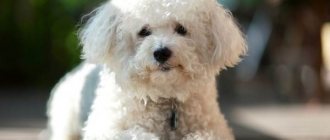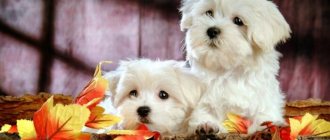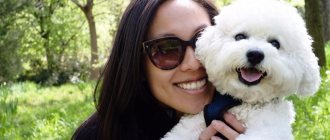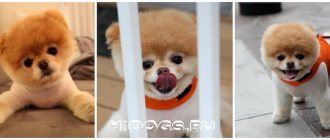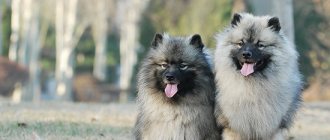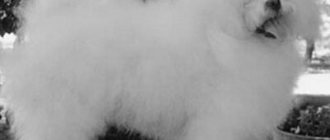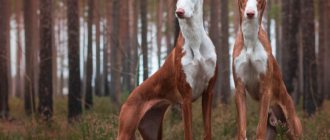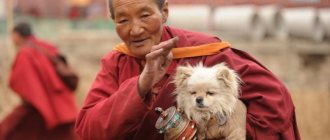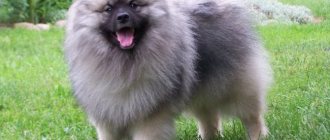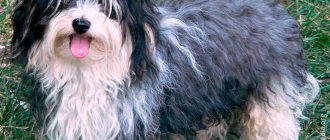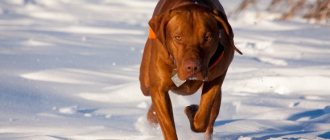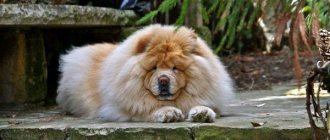Description of the Bichon Frize breed
Popularity 231st among 263 dog breeds
Lifespan:
13-15 years old
Breed group:
Decorative
Height:
25-30 cm
Country of origin:
Belgium, France
Average price:
30-35 thousand rubles
Weight:
2.5-3 kg
Latest articles Cat health
Ataxia in cats: what it is, how it manifests itself and is treated 01/23/2022 151 0 0
Cat health
Leukemia, or viral leukemia in cats 01/23/2022 140 0 0
Advantages and disadvantages
- Pros:
- have permanent friendliness, get along with children;
- amenable to training, the owners will note the Bichon Frize’s eagerness to learn something new;
- hypoallergenic and lacking a characteristic odor.
- Minuses:
- the light curly coat of the French lapdog requires careful daily care and a monthly trip to the groomer;
- tendency to eye diseases and allergies;
- The dog doesn't mind begging for food from the table.
Advantages and disadvantages of the Bichon Frize
Each breed has both positive and negative sides, including French lap dogs. The potential owner should be aware of the following features indicated in the table.
Positive and negative qualities
| pros | Minuses |
| Playful and cheerful in nature | No guard dog potential |
| Excellent predisposition to training | Loud voice |
| The coat is hypoallergenic | Can't stand loneliness |
| The dog is suitable for families with children | Necessary haircuts are quite expensive financially |
| Ideal for apartment living | |
| Elegant appearance | |
| Good health |
Key facts
Loyalty, affectionateness, playfulness, mischief - these are the characteristics of the Bichon Frize breed. Reviews from the owners of French lap dogs speak about one thing: these mischievous little balls of fur win the hearts of people and make people smile with their touching seriousness. Photos, pictures, videos cannot convey the charm of these dogs.
The Bichon Frize is a companion dog, a little mischievous, smart, completely silent, and has the indescribable charm of a walking cloud. Responds to sonorous calls. She loves children, active walks and everyone's attention to her person. Occasionally, a dog may express indignation with a menacing growl or a demonstrative refusal to eat. It is easy to train, but due to its character it can be undisciplined.
The dog practically does not shed, but the dense undercoat and white hair twisted into tight spirals requires careful grooming and daily combing. The description of the Bichon Frize breed explains that the dogs are hypoallergenic due to the absence of the characteristic dog odor and shedding.
Other names of the breed are used along with this one by the International Canine Association: French lapdog, curly-haired bichon.
The shortened name, "barbichon", comes from the merger of two French words "barbet" and "bichon". The dimensions of the Bichon Frize are miniature: weight in adult females and males ranges between 2.5 and 3 kg, height (height at the withers) is 25-30 cm. These values are typical for dogs in the “standard” category. Countries of origin: France and Belgium.
The lifespan of the Bichon Frize is long: they live approximately 12-15 years. The price for a dog starts from 30,000 rubles.
What does a French lapdog look like, what colors are characteristic of it? The Barbichon is a dog of a “dry” build, with an elongated muzzle tapering towards a black nose and playful black beady eyes. Often puppies are born cream colored and only become pure white by 12 months; No more than 10% of the cream “additive” is allowed in an adult.
Breed standard
French dog handlers determined what qualities the Bichon Frize breed should meet, and this happened in 1933. Somewhat later, already in the 70s, lap dogs were approved in the United States and England.
The standard looks like this:
- weight – 3 – 6 kg;
- height at withers – no more than 30 cm;
- color - only white. The length of the coat is 7–10 cm, there are corkscrew curls. This specific structure ensures little hair loss during the molting season;
- life expectancy – a small pet will delight its owner for 12 – 15 years;
- character trait - lapdogs are completely non-aggressive, they are sociable, playful and good-natured. Frisian affection reaches such a degree that animals are ready to follow a person everywhere just so as not to be left alone;
- intellectual qualities were rated above average. It is common for a pet to quickly learn the rules of life in a new habitat. The dogs are highly trainable;
- security qualities are poorly developed;
- The body is rectangular, the cervical region is strong, rounded, flexible, widening towards the shoulders. The withers are inconspicuous;
- The sternum is wide, of sufficient depth, and has a rounded keel. The belly should be tucked up and not drooping, which will interfere with the dog’s movement;
- paws with well-developed muscles, located parallel to each other.
History of the origin of the Bichon Frize
The ancestors of French lap dogs (descended from water barbettes) were active travelers. The homeland of these dogs is considered to be the Mediterranean, where people were able to recognize mouse-hunting animals as faithful helpers. Soon, not a single ship sailed without the ancestors of the Bichon Frize: the dogs masterfully hunted mice.
Just as animals influenced the atmosphere on a ship, so life on the high seas influenced them. The dog's size has decreased. The fur turned white to protect the animal from overheating. The eyes are darkened (restriction of sunlight reaching the retina). The nose became black, which made it possible to better evaporate moisture from its surface.
Slowly but surely, the dogs left the ships and settled in Italy (Italian lapdog), Spain (Maltese lapdog), France (Bichon Frize), and the Canary Islands (Tenerife Bichon). Even in France, the Bichon Frize was originally called the Tenerife Bichon.
The curly-haired Bichon was very popular during the Renaissance and was considered an expensive breed. Puppies often became valuable gifts or “bargaining chips” in large transactions. Many paintings of this era, in which noble people were always accompanied by a small curly dog, can confirm the elite nature of the Bichon Frize.
The long life at court played a cruel joke on the curly-haired lapdogs: the animals, not adapted to the harsh conditions, did not survive the Second World War well. Only the efforts of French and Belgian breeders helped restore the breed's numbers. The Bichon Frize was registered by the International Canine Association in 1933. The breed standard was formed a year later.
History of the breed
The breed has a history of several centuries, and according to experts, the direct ancestor of the Bichon was the Tenerife lapdog, a very popular dog during the Renaissance. At that time, these were real hunters who, not without success, destroyed rats in the holds of ships. By the way, the small size of curly-haired dogs also speaks in favor of this fact. There is little space in the cabin, and therefore a large pet accompanying its owner would experience some discomfort in a small area. Another ancestor of French lap dogs is called water spaniels.
In the 15th century, this breed became the object of love among the Italian and Spanish aristocracy, and 100 years later the French nobility paid attention to them. It was the French who gave the name to the dogs “Barbichon”, which can be translated as a small poodle; a little later the name was shortened to “Bichon” - lapdog. The word “frise” is translated as “curly,” which indicates the quality of the coat.
Over its long history, the breed has had both ups and downs; at some point the dogs were on the verge of extinction, but already in the twentieth century their popularity began to actively grow, and today you can meet Bichons almost everywhere.
Appearance of a French lap dog
General impression
There are many types of lap dogs - Italian, Maltese, French... What does a French Bichon Frize look like? The curly-haired Bichon is a small fluffy cloud, he is graceful and elegant. The fur twisted into spirals is pure white, black eyes look at the owner devotedly, but cunningly. Small size (height for females reaches 23-29 cm, for males - 25-30 cm), low weight (from 3 to 5 kg) make the Bichon look like a plush toy.
Head
The head, proportional to the body, is distinguished by a flat skull, which appears rounded due to the hair.
The brow ridges are weakly expressed. The ears, set above the eye line, form an equilateral triangle and hang along the cheeks; heavily covered with hair. Usually the dog actively moves its ears if something attracts its attention. The muzzle, wide at the base, is shorter than the skull; the bridge of the nose is straight. The round dark eyes are normally set, the whites are not visible when viewed directly. The rounded black nose is grainy and shiny. Dark thin lips are thin, the lower lip is not visible when the mouth is closed. The cheeks are flat and high cheekbones. Both jaws are wide, with even incisors; a scissor bite is preferred, with a full set of teeth.
Neck
Thin near the skull, the neck smoothly widens and goes into the shoulders. Long, in proportion it is a third of the length of the entire body.
Torso
The photo of the Bichon Frize clearly shows that its body is compact, with well-defined withers. The back is straight, there is a slight bend in the lumbar region, the muscles are well developed. The wide, rounded croup has a slight slope. The chest is well developed, reaching down to the elbows; the ribs are springy. The lower part of the chest rises towards the moderately tucked abdomen; The sides are lean, the skin is without folds.
Forelegs
The front legs are straight, the bones are thin. The shoulders are oblique, forming an angle with the top of the paw. The elbows located close to the chest smoothly flow into the straight forearm. The feet are round with black pads and claws, well assembled. When standing, the dog places its paws straight.
Hind limbs
The hind limbs of the Bichon Frize begin with a wide pelvis, thighs with well-developed muscles, and vertical legs parallel to each other. The knee is neither turned in nor out. The shin is similar in length to the thigh. The hock joint is well defined, the metatarsus is thin. The paws are rounded, the characteristics of the pads and claws are the same as those of the front ones.
Tail
The tail is carried moderately high and does not curl or touch the back. Doesn't stop. Possibly touching the back with fur. When moving, the tail carries gracefully and does not hang.
Movements
When walking, the movement of the paws is parallel. Trotting is accompanied by a head carried high and a tail well curled over the back. The hind legs are especially powerful and give good acceleration. Movements are free and graceful.
Wool
Girls and boys squeal with affection when they see French lap dogs that look so much like little clouds! The dog's undercoat is soft and dense. The coat is curly, voluminous due to the spiral-shaped outer hair. The length ranges from 7 to 10 cm. The curly Bichon will not get wet even in a downpour due to its thick undercoat.
Color
What colors predominate in the Bichon Frize? Up to 12 months, the puppy's coat may be beige (a mixture of white and champagne), covering no more than 10% of the animal's body. An adult dog has a bright snow-white coat.
Size
The height of the Bichon Frize at the withers is small and reaches a maximum of 30 centimeters. These are truly miniature dogs, ideal for home keeping. The weight of the Bichon Frize is also small and ranges from 2.5-3 kg.
Bichon Frize personality
What makes the Bichon Frize so special? A rare curly-haired Bichon will turn out to be a lazy “sleepyhead”: most dogs of this breed contain a kind character and an endless supply of energy in a small body. Friendliness, activity, and playfulness are especially evident when the Barbichon is walking on the street. Other animals do not disturb the dog. Sociability is a distinctive feature of the French lapdog, which is especially evident when playing with people. Dogs feel comfortable at home - both in an apartment and in a cottage.
The puppies quickly adapt to their new home. Living side by side with children is not scary for French lap dogs. Little Barbichons quickly and with interest get to know the world. Adult dogs are also actively learning about life.
Due to their pretty appearance, pleasant character and love of communication, Barbichons often become participants in “pet therapy” in children's hospitals and nursing homes. In addition, especially well-trained animals become good watchmen - strangers are frightened by their ringing voice.
Who is the curly-haired Bichon dog suitable for? People who are not afraid of changes and something unexpected in the usual course of days. If you get a Barbichon, be prepared to lead an active lifestyle and have a lot of fun with a devoted friend - for example, looking for a snow-white Bichon Frize in the snow outside in winter!
Varieties
Today, several breed subgroups have been identified, which include lapdogs with similar appearance and characteristics. They differ in the place of breeding and growth.
You can get acquainted with the varieties of Bichons in the table below.
Breed diversity
| Breed name | Short description | Peculiarity |
| Havanese (Havanese Bichon) | They have a lush coat, which can be either white or have various shades of brown, spotting is allowed. Representatives of the breed get along well with children and pets. | Highly people-oriented. If a dog is left alone for a long time, it will find entertainment in the form of damaging furniture, carpets, etc. Havanese is considered a rare breed in the Russian Federation |
| Bolognese dogs (Bolognese) | The short fur on the face becomes longer on the rest of the body. The dogs have a square-shaped body, unlike other Bichons. | The dog's complete inability to remain alone for more than a few hours. If the owner of the Bolognese leaves the house for a long time, then the neighbors will have to listen to the dog’s very loud protests expressed by barking or howling. |
| Maltese dogs (Maltese) | Belong to the decorative group. The coat is long and requires careful care from humans. Despite the lack of watchdog qualities, the Maltese will easily bark at a stranger, and may even bite him. | The lack of undercoat makes representatives of the breed desirable pets in the home of people with allergies. It is especially worth noting that Maltese dogs have diseases that are inherited. Just like other Bichons, they cannot stand being alone. |
| Levchens (lion dogs) | They are also lap dogs and have a friendly and affectionate character. Do not show aggression towards other pets | There are no genetic diseases. There is no shedding process as such in dogs. Taking care of the pet’s coat will take up quite a lot of the owner’s time, and periodic visits to the groomer are not a cheap pleasure |
| Coton de Tulear (Madagascar Bichon) | They are similar to Havanese, and breeding work on natives from Madagascar has not been completed to date | Ideal pets for families. The dogs are very attentive, playful, and vigilant. Perfectly adaptable both in an apartment and in a country house. Cotons require intensive socialization and appropriate training to avoid behavior problems. |
| Russian colored lapdogs | For this breed, the standard provides for any colors, with the exception of snow-white. The dog is very intelligent and clearly captures the mood of the owner | Activity and endurance allow the lapdog to take long walks with the owner. Thanks to its good adaptability to transportation, the dog will be able to go with a person on any trip. |
Education and training
How to raise a curly-haired Bichon? Quite simply, because lap dogs are very smart! The dog easily learns basic and complex commands. Thanks to this, the curly-haired Bichon is often seen in the circus arena.
First, you should understand that a proud Barbichon will not tolerate disrespectful treatment: shouting or brute force. Raising and training a Bichon Frize ideally begins at two to three months, when the puppy’s temperament has not yet deteriorated. You should increase the training time and the amount of exercises gradually, not forgetting to give your pet time to rest and motivate him with something edible.
In addition, timely training will help wean your French lapdog from its characteristic habit of gnawing and biting its fingers during games.
Pets rarely tolerate eye washing, ear cleaning and brushing. These procedures are necessary to maintain the dog’s beauty, especially in autumn, winter, spring, when wearing a warm suit is necessary, but do not forget about them in the summer. If your pet refuses to sit still, treats will be a reward for good behavior.
Is it possible to stop admiring a trained and raised Bichon Frize? The answer is clear - no!
Bichon Frize Health and Diseases
Possible diseases
French lapdogs are lucky with their genes; they rarely have congenital diseases.
But allergies, especially to food, are common (the actual question is what to feed your French lapdog). Allergies cause the color of the fur on the paws between the toes, under the tail, around the eyes and ears, and on the face to deteriorate. The curly-haired Bichon is also susceptible to obesity, the treatment of which can take a long time. The French Bichon is prone to the following diseases:
- hypothyroidism - dysfunction of the thyroid gland;
- dermatitis is an inflammatory disease of all layers of the dermis;
- epilepsy;
- instability of the second cervical vertebra;
- urolithiasis disease;
- cataract - clouding of the lens;
- entropion - inversion of the eyelids;
- corneal clouding;
- diabetes;
- allergic reaction to food, vaccinations.
The curly-haired Bichon's weekly grooming routine includes brushing his teeth, bathing, and trimming his muzzle and genitals.
Diseases of the musculoskeletal system are not typical for representatives of the Bichon Frize breed. But their joints are fragile, especially before 12 months, which can lead to paw fractures. The life of a Bichon Frize is relatively long (from 12 to 15 years), and from birth to old age, the Barbichon remains optimistic and loyal to its owner.
Reproductive health
The first estrus in female dogs occurs at approximately 10-12 months, but veterinarians advise planning offspring only during the second or third estrus, since the dog’s body is not yet ready for pregnancy and childbirth. The difficulty of childbirth depends on the size of the bitch and the number of puppies. If the Bichon Frize is not allowed for breeding or the owner does not want to bother with the puppies, sterilization will be a profitable option.
Features of feeding and diet
Representatives of small breed dogs are characterized by obesity due to an incorrectly chosen or unbalanced diet (when BZH standards are not met). Barbichons are no exception, so you should carefully monitor what the dog eats. Two “menu” options for dogs are useful: dry food and natural food. Only the owner decides what to feed the animal. It should be noted that with natural feeding, vitamin complexes must be present in the diet.
How many times should you feed your Bichon Frize? How much should I feed my puppy? A one-month-old puppy is given five or six meals a day in small portions; It is possible to include dairy products and raw vegetables in the diet. At the age of 5-8 months, the curly-haired Bichon is transferred to three meals a day. Feeding of an adult occurs twice a day.
What food should I feed my curly-haired Bichon? Is it possible to give any products other than drying? The choice of food is an important matter. The level of health depends on what dry mixture the dog will eat. Often a Barbichon has an intolerance to a particular ingredient, which can lead to allergies. It will be beneficial to introduce raw vegetables into your dog's diet.
Often, veterinarians will advise you to buy a puppy feeding guide or an adult dog feeding guide if you have no experience keeping an animal.
Maintenance and care
How to care for a French lapdog? This breed is suitable for allergy sufferers (due to the lack of shedding), but lazy people cannot cope with frequent walking of the dog or caring for it. Long-haired dogs need to be brushed every day - white hair requires careful grooming.
After long walks, the Bichon Frize needs to be bathed, carefully washing off the dust from the fur and rounded paws, carefully cleaning the face, eyes and nose using cotton pads. If your dog behaves strangely while washing, it may be that water has gotten into his ears. It is also necessary to monitor the condition of the Bichon Frize's oral cavity, because if there is an excess of simple carbohydrates in the diet, caries can form on the teeth.
Keeping and caring for a Bichon Frize includes monthly visits to the groomer to keep the dog in good condition. Grooming is a range of animal care services: cutting hair, claws, cleaning ears, mouth. Even if the curly-haired Bichon is not a show-class dog, it is recommended to have it cut by a professional.
Maintenance, care
Frizes are the owners of a luxurious coat, in addition, their coat will grow throughout their lives, just like human hair. Due to such features, any owner needs to know what kind of care French lap dogs need. One of the mandatory requirements is timely grooming.
It is necessary to comb your pet every day, which will prevent the fur from falling into tangles. For care, you will need to purchase combs with teeth of different frequencies. The undercoat is combed out with a slicker brush, and a massage brush is used for styling. There are special sprays that make grooming easier.
As for water treatments, you need to wash your pet twice a month, using special shampoos. If allergic reactions occur, you need to change the cosmetic product.
Good to know. For walks in spring and autumn, it is recommended to purchase clothing for dogs that will perform a protective function for the coat. After washing is completed, the lapdog must be thoroughly dried to prevent the formation of fungal diseases.
Bichons are groomed once every one and a half to two months to maintain hygiene.
Feeding
Frises may be miniature dogs, but they have an excellent appetite, and at the same time there is no measure. To prevent overfeeding, the owner will need to carefully follow the diet of their pet.
Both ready-made food and natural products are used as food. From these options, you need to choose one and use only that one. It is strictly forbidden to mix the two types of feeding.
Note to dog breeders. This breed has a high tendency to allergic reactions to food, and therefore when choosing food you should always remember this feature. To avoid health problems, the owner must monitor how the pet reacts to certain changes in the diet.
If we talk about ready-made food, then you should give preference to well-known brands and premium products. When cooking on your own, you need to remember what ingredients frisée must include:
- meat products, raw or heat-treated;
- boneless fish;
- porridge (rice, oatmeal);
- vegetable and fruit crops (you can make puree).
As for bones, it is not recommended to give them to dogs, especially the tubular varieties. Their fragments damage the digestive system. Very often, Bichons do not tolerate dairy products and poultry meat.
Upbringing
The intelligence and intelligence of French lap dogs has already been discussed several times in the article. A potential owner should take into account that dogs are quite headstrong and can be distracted by extraneous noise. To avoid this, it is necessary to carry out some educational work.
When training, you should adhere to the following criteria:
- maintain consistency and caution;
- dogs perfectly understand a person’s mood, and if the owner is interested in training and is happy with the results obtained, then the pet will approach the matter more responsibly;
- the basic commands are initially learned: “No!”, “Place!”, “Come to me!”;
- display of aggression and cruelty towards a Bichon ends with the animal simply refusing to obey.
Parenting mistakes
Very often lap dogs suffer from permissiveness and “small dog syndrome”; such manifestations on the part of the owner spoil the positive character traits of the four-legged dog and lead to them becoming uncontrollable during walks. This behavior is fraught with unpleasant situations.
A strong focus on people, and a lack of attention from the owner, make representatives of the breed vandals and hooligans who cause trouble not only to the people around them on the streets, but also to the owners of such an animal themselves.
Tips for choosing a puppy
In Russia, the Bichon Frize breed has become popular relatively recently, and people do not know what a French lapdog puppy should look like. Meanwhile, the appearance of month-old purebred puppies is almost no different from the appearance of mongrels.
How to choose a puppy to be happy? Firstly, if the purpose of the purchase is participation in exhibitions, it is recommended to pay for a consultation with a dog handler; The cost of the consultation includes assistance in choosing an individual with a minimum number of defects or their complete absence. Secondly, the best choice would be to buy a French lapdog from a kennel. Bichon Frize puppies from kennels are purebred and in good health. Thirdly, you can communicate with your future pet in advance to eliminate excessive aggressiveness, cowardice, and nervousness.
List of Russian nurseries where Bichon Frize dogs are bred:
- "Gentle velvet" (Moscow);
- "Imperial gold" (St. Petersburg);
- "Kuner's" (St. Petersburg);
- “Moment of glory” (St. Petersburg);
- "White Rivendel" (Novosibirsk);
- "White Star" (Korolev);
- "Yarika's" (Murmansk);
- "Exotic Paradise" (Chekhov).
Having chosen a dog, do not forget to ask the breeder for a puppy certificate (there is information about the individual’s strengths and vices, physical characteristics), and a veterinary passport with vaccination marks in it. The price of a puppy directly depends on these documents, as well as on the individual’s admission to breeding.
Puppies
Choosing a puppy
A purebred Bichon Frize is a rather rare dog, and therefore a potential owner must be able to correctly distinguish a representative of the breed he needs. Before purchasing, you must carefully familiarize yourself with all the characteristics that a French lap dog should have. It is important to know that such four-legged animals are very similar to the Maltese representatives of this species.
It is best to purchase a puppy from trusted breeders. If a person’s plans include breeding this breed, it is worth contacting a specialist who will help you make the right choice. Go to a show, look at the dogs and make a reservation for a puppy from a couple that meets the required level. If you are simply choosing a pet for a family, then it is enough to obtain information about the health of the bitch and male, as well as about the previous litters of these parents. In any case, upon examination, the puppy should be active and behave appropriately for its age.
Price
If there is no pedigree, they may ask for a dog from 10,000 to 15,000 rubles. The presence of the necessary package of documents raises the cost from 15,000 to 500,000, everything will depend on the class. Very often you can buy a mixed breed frize and some other small dog, here the price category is 7000 - 8000 rubles.
How much does a Bichon Frize cost?
How much does a Bichon Frize puppy cost? A young French lap dog will cost an average of 30,000 rubles. A pet, a future participant in exhibitions, is usually born to champion parents: the title adds at least 20,000 rubles to the cost. That is, a show-class dog can cost from 50,000 to 90,000 rubles.
In addition, there is a category of puppies that are not allowed for breeding due to defects in appearance; the price of a Bichon Frize with a defect is significantly lower - 20,000-25,000 thousand rubles. After the sale, good nurseries continue to monitor the life of their graduate.
The Bichon Frize is a cute mischief maker, a charming fluffy cloud, and a charming watchman. The dog will be a faithful friend to its owner throughout its long and interesting life.
Do you like the article? 0
